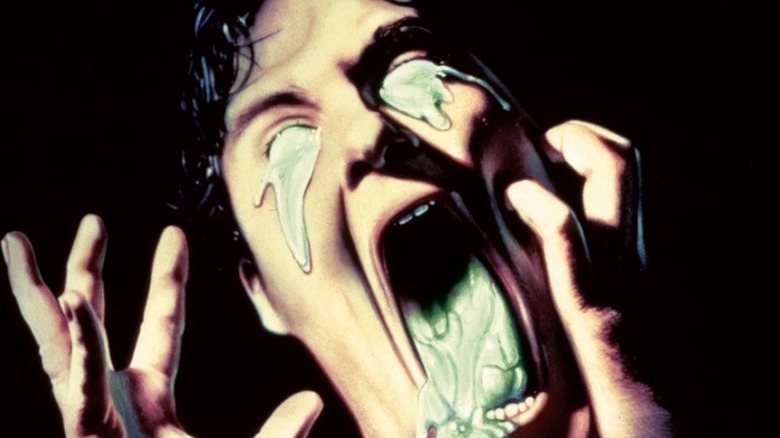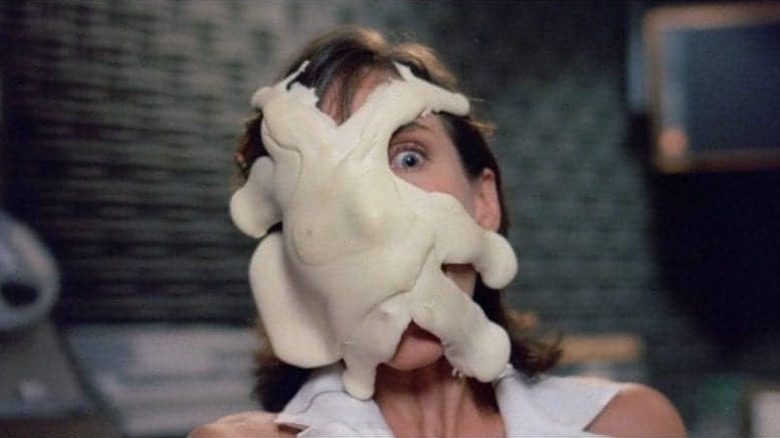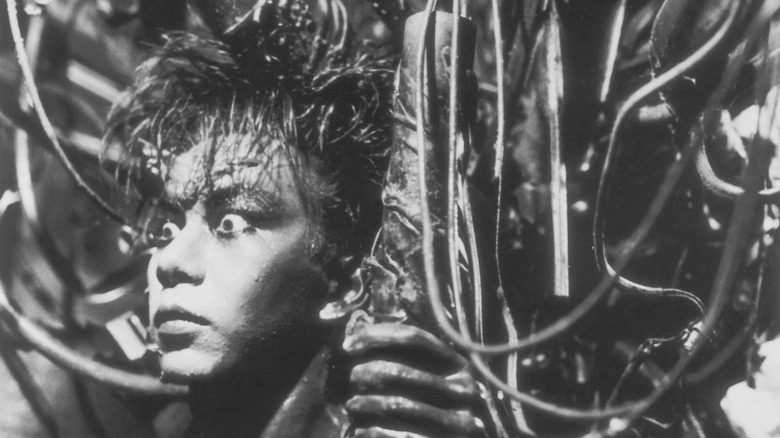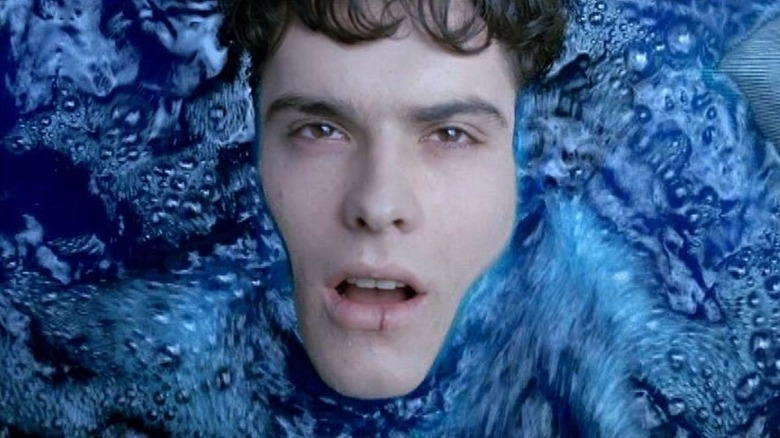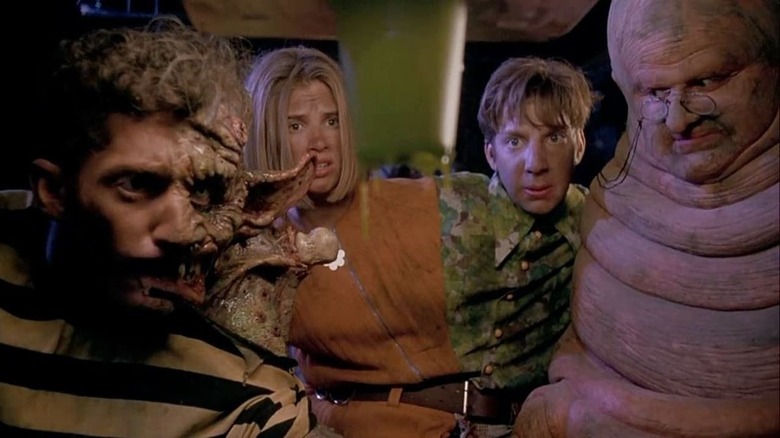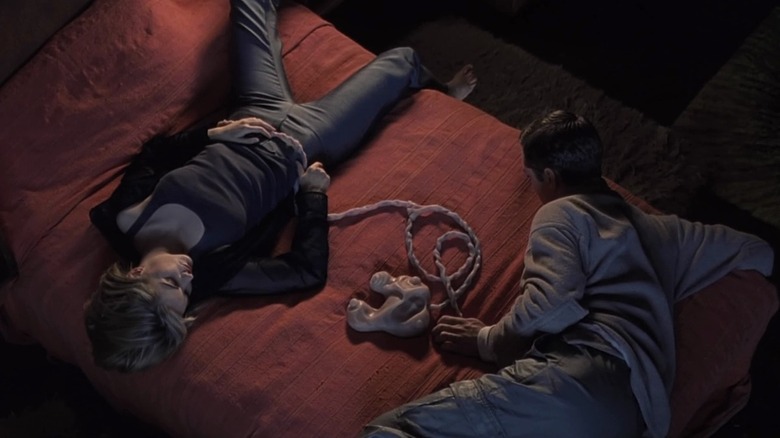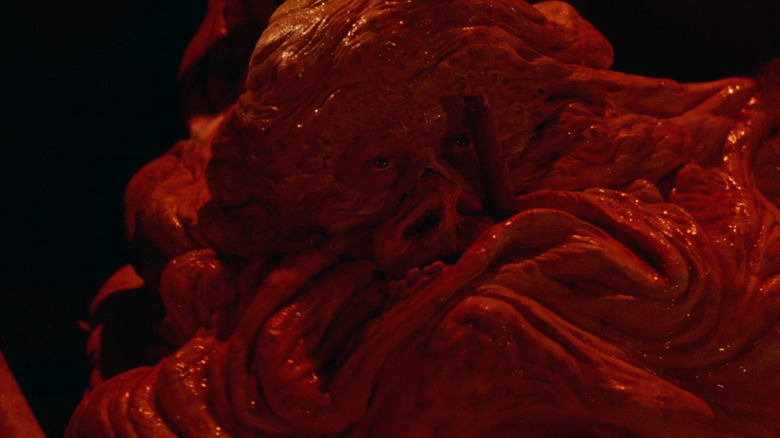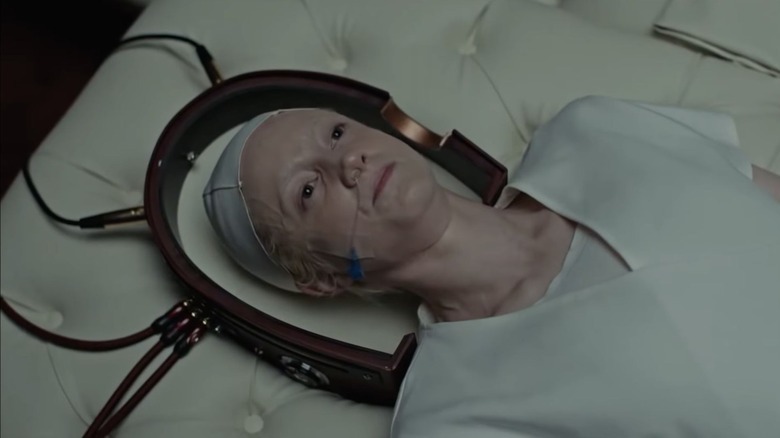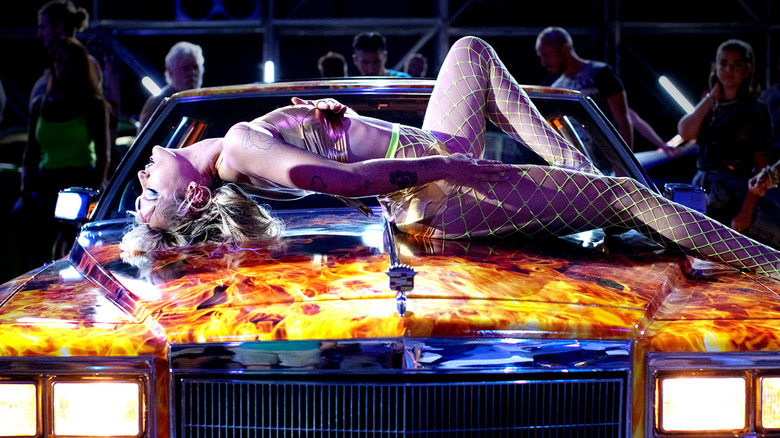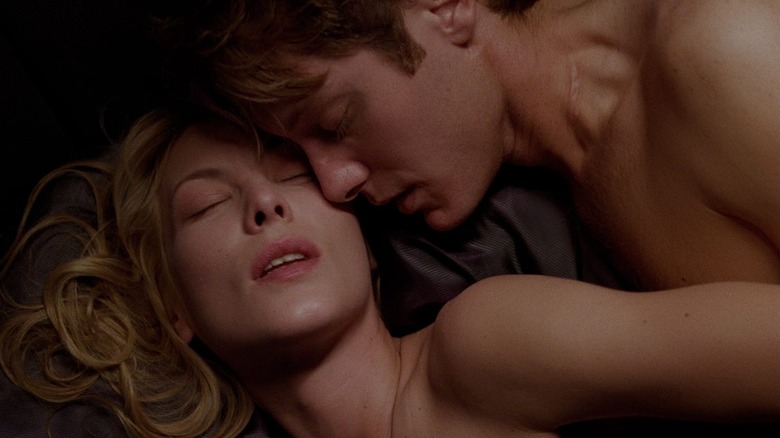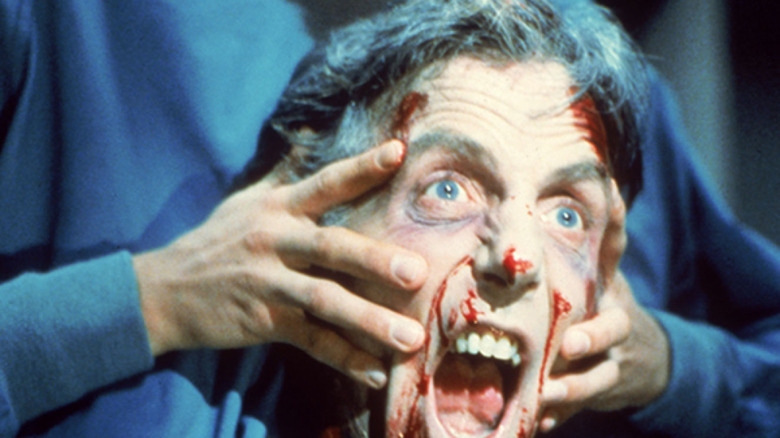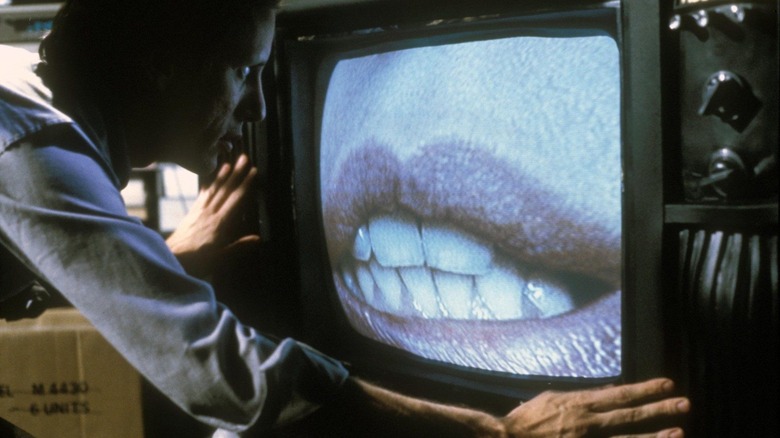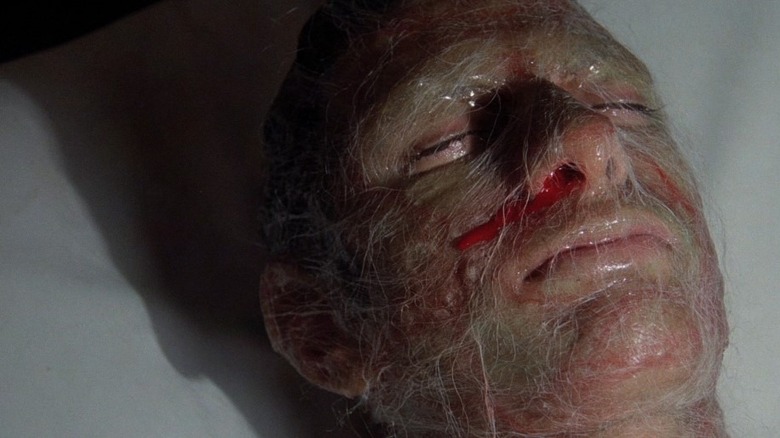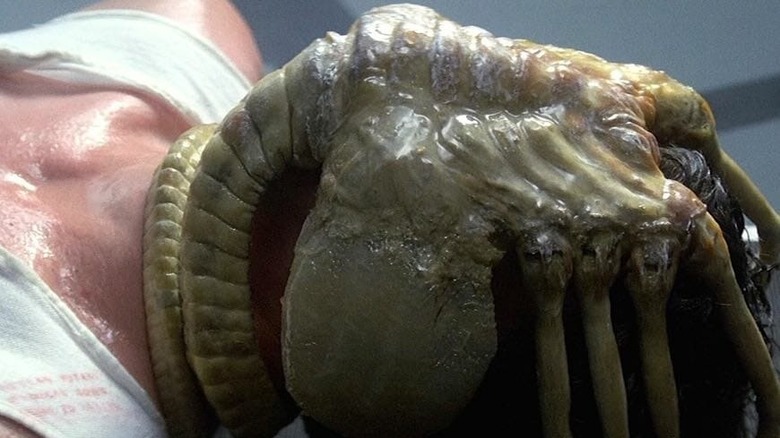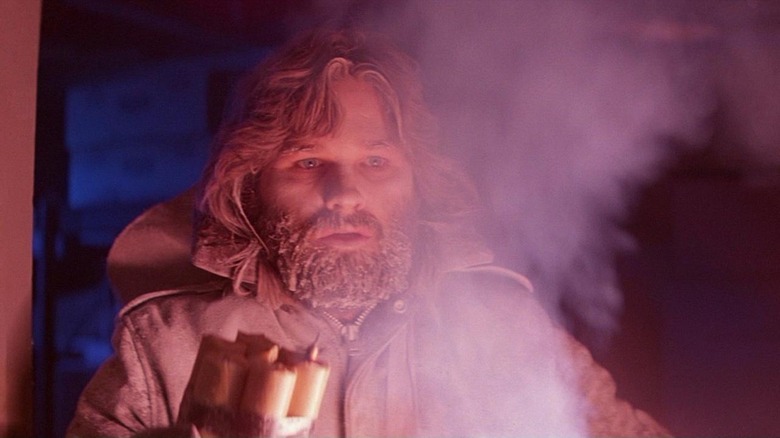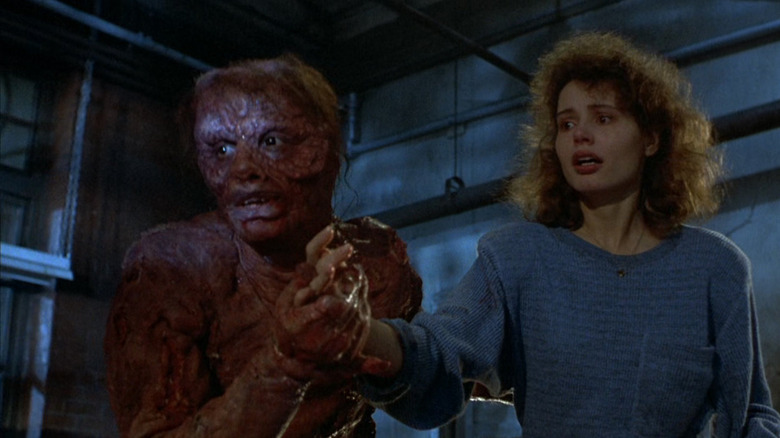The 15 Best Body Horror Movies, Ranked
Body horror is without a doubt one of the most viscerally affecting subgenres in cinema. In an essay for The Rumpus on body horror and its relationship with later period capitalism, Davey Davis wrote, "Far more than being merely stomach-turning, [body horror] runs fantastically and viciously rampant with the anxieties we all have about our own physical vulnerability." Part of what makes body horror films so effective is their obsessive preoccupation with the corporeal, the carnal, and the contaminated.
Even under the umbrella of these signifiers, body horror is a very diverse aisle of the proverbial video store, with no universal consensus on what is or isn't a proper body horror picture. While there have been many examples of body horror in animation ("Princess Mononoke" and "Akira," for example, contain elements of it), this list will be focused strictly on live-action movies. Here are 16 of the best body horror films ever made.
15. The Stuff
Either "The Blob" or its 1988 remake could have made this list, but as far as viscous body horror films go, consider checking out "The Stuff" instead. A 1985 picture from schlock maestro Larry Cohen ("It's Alive," "Maniac Cop"), "The Stuff" recounts the story of a sentient white goop that bubbles up from beneath the earth and begins taking over peoples' minds, turning them into Stuff-addicted drones. When the Stuff is marketed to the masses as an ice cream alternative, the only people standing in its way are Michael Moriarty's ex-FBI agent, an ad executive (Andrea Marcovicci), and a precocious boy named Jason.
"The Stuff" has everything: "Saturday Night Live" original cast member Garrett Morris, a cameo by Danny Aiello, Paul Sorvino as the leader of an army of right-wing survivalists, the woman from the Wendy's "Where's the beef?" commercials, and the immortal line "Well, everybody's got to eat shaving cream once in a while."
14. Tetsuo: The Iron Man
When discussing body horror, it would be foolish to overlook the legacy of pioneering Japanese cyberpunk splatter-fest "Tetsuo: The Iron Man." Released just a year after "Akira" (which famously also features a character named Tetsuo whose body fuses with machinery), Shinya Tsukamato's short but unforgettable film tells the story of an ordinary salaryman undergoing a surprising cyborg transmogrification. Tomorrow Taguchi's protagonist (referred to simply as "Man" in the credits) is bedeviled by a fetishistic maniac obsessed with all things metallic, and the carnage and X-rated insanity that follow are truly something to behold.
Midnight movie expert Michael J. Weldon described "Tetsuo: The Iron Man" in his Psychotronic Video magazine as a "fast-paced, shocking, scary (and funny!) movie [that] features stop motion, surprising special effects, monsters, a mutant cat, flashback sex, and lots of sweat, pain, spurting blood, maggots, mutating and loud screams." "Tetsuo: The Iron Man" also features a sex scene that may be even more obscene and outrageous than some of the other films listed here, so viewers beware.
13. Brain Damage
Frank Henenlotter's 1988 take on Nancy Reagan's "Just Say No" campaign, "Brain Damage," is a lurid and profane portrayal of addiction. Rick Hearst stars as Brian, a disaffected New Yorker who encounters an anthropomorphic alien slug named Aylmer, who's voiced by cult horror movie host John Zacherle. Aylmer subsists by injecting human hosts at the nape of their neck with a proboscis that feeds them an ecstasy-like hallucinogenic liquid. He also eats brains, and "Brain Damage" does not shy away from depicting this as graphically as possible.
This darkly funny low budget gem, shot on location in the last vestiges of grimy '80s Manhattan, is soaked in vibrant retro lighting and borders on reprehensible. According to Henenlotter, the crew walked off during the filming of one particularly explicit scene. "Brain Damage" is also notable for being the only film listed here to feature a musical number.
12. Freaked
While "Freaked" is frustratingly hard to track down, if you can find it you're in for a hell of a good time. Co-directed by "Bill & Ted's Excellent Adventure" star Alex Winter and Tom Stern, "Freaked" stars Winter as a narcissistic actor named Ricky Coogan who is hired by a nefarious corporation to be the spokesperson for a chemical compound called Zygrot 24. En route to the company's South American factory, hijinks ensue and Coogan finds himself at a "freak farm" overseen by Randy Quaid's Elijah C. Skuggs. There, he meets a makeshift family of mutants that includes a man with a sock for a head (Bobcat Goldthwaite), a bearded lady (Mr. T), a giant worm-man, a character who's basically just a nose, and a bipedal cow named "Cowboy" played by John Hawkes.
Coogan soon finds himself deformed at the hands of Skuggs and his "Tasty Freaks Machine" and must band together with the farm's other misfits to plot their escape. "Freaked" also includes cameos by Winter's "Bill and Ted's Bogus Journey" co-stars William Sadler and an uncredited Keanu Reeves as the Che Guevara-esque Ortiz the Dog Boy. Screaming Mad George, a Japanese emigrant who also contributed to "Predator" and "Big Trouble in Little China," lent his talents to the film's elaborate effects.
11. eXistenZ
"eXistenZ" is auteur David Cronenberg's grand statement on video game culture, injected with his signature body horror inclinations. In what hopefully doesn't stand as his final effort in this subgenre, Jude Law and Jennifer Jason Leigh star as a marketing agent and world famous game developer, respectively, who get ensnared in a deadly conspiracy in the near-future. Leigh's Allegra Geller has pioneered an immersive new game platform that involves squirming, sexualized consoles that literally plug into their users' bodies.
Similarities abound to Cronenberg's "Videodrome" (more on that film later). There is a fleshy gun that shoots human teeth as bullets, and the ending is both ambiguous and horrifying. Much like its fellow 1999 classic "The Matrix," "eXistenZ" features nested realities and interrogates what is real and what is virtual. It's a remarkably prescient film that speaks to our increasingly detached and digitally-rapt world, despite dripping with dated turn-of-the-century aesthetics. As Law's Ted Pikul puts it, "Everything here is dirty, absurd, grotesque!"
10. Society
If you can stomach it — there is a very good chance that this film is the most disgusting entry on this list — director Brian Yuzna's "Society" is well worth your time. This 1989 cult flick starts out as a soapy teen melodrama before metamorphosing into a revolting and perverse satire about the superficiality of the Beverly Hills bourgeoisie. We watch as high school senior Bill (Billy Warlock) grows increasingly paranoid and comes to suspect that something sinister is lurking under his neighborhood's sunny facade.
What Bill comes to learn is that virtually everyone else in the Hills are aliens of unknown origin who literally feast on the poor. The film's unforgettable climax is what makes it truly remarkable: The third act centerpiece, "the Shunt," is a massive, incestual, cannibalistic orgy in a ritzy Los Angeles mansion. Set to Strauss' "The Blue Danube," the Shunt is a writhing bacchanalia of contorted limbs, fused flesh, slimy mutations, and torture. Once again, these debauched and debased special effects were the work of the ever-impressive Screaming Mad George.
9. Possessor
2020's "Possessor" is the second mind-bending feature from Brandon Cronenberg, son of David, the king of body horror. Though he's denied drawing inspiration from his father's "eXistenZ," the similarities are hard to deny. For example, both films include Jennifer Jason Leigh as an inscrutable higher-up at a mysterious corporation. As Cronenberg says, the film's psychedelic imagery drew inspiration from giallo auteur Dario Agrento's "Opera."
The plot of "Possessor" concerns a mercenary named Tasya Vos, played by Andrea Riseborough ("Mandy"), who utilizes an unexplained technology to hijack other peoples' brains in order to execute her targets with zero consequences. Things go terribly awry during her latest mission, and before long the boundaries between Tasya and her host body begin to blur, leading their identities to battle one another for control. What follows is a nightmarish procession of ultraviolence and psychological warfare. Like the best body horror films, "Possessor" explores the intersections between sexuality and violence, but it's also distinctly modern, addressing the alienating nature of the metaverse and the loss of privacy and agency in the digital age.
8. Titane
Julia Decourneau's mesmerizing 2021 Palme d'Or winner "Titane" toes the line between body horror, magical realism, and New French Extremity. But it's so much more than that — it's equal parts brainy, gory, suspenseful, and unexpectedly tender. "Titane" stars Agathe Rousselle as Alexia, an exotic dancer who performs at car shows and has a metal plate in her head, the result of a devastating car crash she survived as a child. Alexia's obsession with automobiles goes beyond mere admiration, however, and veers into the erotic (to elaborate further would be to spoil one of the film's many surprises; "Titane" is a ride best enjoyed with little to no context).
In his book "Terminal Identity: The Virtual Subject in Postmodern Science Fiction," film scholar Scott Bukatman ruminates on the "Cyborg Manifesto" of feminist theorist Donna Haraway, something that "Titane" evokes, whether intentionally or not. "Haraway's new cyborg mythology ... overturns the artificial discontinuities of gender-based ideology," Bukatman says. Performative gender identity, toxic masculinity, and psychopathy are only some of elements rumbling around in the film's souped-up engine. That said, "Titane" is far from an antiseptic intellectual exercise. It's every bit as shocking and violent as Decourneau's 2016 cannibal coming-of-age film "Raw."
7. Crash
Released at the tail end of the late '80s and mid-'90s erotic thriller boom, "Crash" adapts J.G. Ballard's lightning-rod novel of the same name, which he termed "the first pornographic novel based on technology." Widely considered one of David Cronenberg's finest films, "Crash" explores a seedy subculture of fetishists afflicted with symphorophilia who get a sexual thrill from staging car accidents. They adhere to a "benevolent psychopathology" that believes car crashes are "fertilizing" events. James Spader stars as a polyamorous bisexual filmmaker under the spell of cultish sadomasochist Dr. Robert Vaughan (Elias Koteas). Holly Hunter and Rosanna Arquette help ground the film's depravity in supporting roles.
Like other films in Cronenberg's oeuvre, "Crash" belies a fascination with wounds, the frailty of human flesh, and the intersection between sexuality, machinery, and mortality. "Crash" won a Cannes Special Jury Prize in 1996, and has endured as a high-water mark for the body horror genre.
6. Re-Animator
Loosely adapted from a serialized novel by H.P. Lovecraft, "Re-Animator" is a seminal work for a number of reasons. The 1985 film marked the directorial debut of the late Stuart Gordon and coronated Barbara Crampton and Jeffrey Combs as horror movie royalty (Crampton would go on to star in "Chopping Mall," "Castle Freak," "You're Next," and "The Lords of Salem"; Combs featured in "From Beyond," "The Frighteners," "House on Haunted Hill," and more). A Brian Yuzna of "Society" fame production, "Re-Animator" stars Bruce Abbott as aspiring medical student Dan Cain. He shortly finds himself in the clutches of his oddball roommate, Herbert West, who's been perfecting a technique for resuscitating the dead. Naturally, West's methods have ... consequences.
Gordon has been quoted as saying "Horror and sex go hand in hand," and boy is that ever on display in "Re-Animator." The climax is outrageously gruesome and, like some other entries on this list, includes a magnificently gory head-crushing. As with the best body horror films, "Re-Animator" also features a deliciously ironic coda.
5. Videodrome
Parsing the plot of David Cronenberg's "Videodrome" is a tall order. It recounts the odyssey of sleazy bootleg cable TV broadcaster Max Renn (James Woods), who becomes fixated on a tumor-inducing pirate video signal that airs horrific snuff footage, and is soon drawn into a larger mystery involving figures with names like Barry Convex and the Dr. Mabuse-esque Brian O'Blivion ("Videodrome" is not particularly subtle in this regard). All the while, Renn undergoes a physical transformation straight out of the body horror textbook: His chest grows a vaginal orifice, and his hand fuses with a pistol (or does it?).
Taking inspiration from the works of philosopher Marshall McLuhan, this BDSM-laden precursor to "eXistenZ" is likewise concerned with screen addiction and the ways in which televised or digital images can warp one's perception. In an essay for The Criterion Collection, Gary Indiana asserts that "'Videodrome' simultaneously suggests and discounts the widespread view that exposure to violent imagery desensitizes us, making us so emotionally numb that we can get sensation only from pain." Undoubtedly one of Cronenberg's greatest triumphs, "Videodrome" won't be his last film to make this list.
4. Invasion of the Body Snatchers
Set against the backdrop of Bay Area bohemia, 1978's "Invasion of the Body Snatchers" shares similarities with the number two pick on this list. It's an exemplary remake of a black-and-white '50s thriller that investigates the incalculable horror of losing autonomy over your own body. Director Philip Kaufman grabs viewers immediately with the film's trippytitle sequence and doesn't relent from there on, proffering an atmosphere of dread and anomie for the duration of the film's runtime.
The cast of "Invasion of the Body Snatchers" is tremendous: Brooke Adams, Veronica Cartwright, Leonard Nimoy as a New Age-y psychiatrist, a young Jeff Goldblum at his squirrelly best, and Donald Sutherland in the lead role of San Francisco health inspector Matthew Bennell. As in the 1958 original, the plot revolves around a parasitic alien incursion that replicates human bodies in order to grow an army of zombies. The film is tactile, disturbing, and unfortunately all too relevant in today's pandemic-ravaged era of disinformation and societal unease.
3. Alien
Typically, denying "Alien" the top spot on a "best of" list would be a crime against cinema. But since this is exclusively body horror we're talking about, and since "Alien" has one insectoid foot firmly planted in the sci-fi genre, top honors will be going to a title that truly embodies pure, unadulterated body horror.
Still, it's the titular Xenomorph's creature's unique life cycle that qualifies "Alien" for this list. Its neonatal form is the "facehugger," which orally impregnates its victims. Afterwards, the Xenomorph fetus gestates inside the unwilling bodies of its prey, ultimately beginning life as a literal "chestburster" before rapidly maturing into an unstoppable seven-foot-tall killing machine.
The extraterrestrial menace embodies a host (pun intended) of human fears. Many critics have noted how "Alien" plays on our anxieties about sex, reproduction, and maternity. According to Scott, though? "Its only point is terror, and more terror."
2. The Thing
In the halcyon summer of 1982, moviegoers could head to the theater and see "Blade Runner," "Mad Max 2: The Road Warrior," "E.T. The Extraterrestrial," "Star Trek II: The Wrath of Khan," "Tron," and John Carpenter's underseen and widely-panned "The Thing," which has since been reappraised and enshrined as an all-time classic of the horror genre and one of the best remakes ever made. Based on the 1938 novella "Who Goes There?," "The Thing" offers a gauntlet of paranoia for its all-male ensemble. In a remote Arctic research facility, an alien shapeshifter crash lands in the nearby tundra and begins possessing the hardened men, moving from host to host on a bloody rampage.
Rob Bottin's creature work on "The Thing" (with an assist from the legendary Stan Winston) is a near-peerless example of the quality of old-school practical effects. Carpenter himself is also operating in complete God mode. Every single frame of "The Thing" is suffused with claustrophobia and dread. As the alien invader's body count rises, the hyper-masculine crew begin to turn on one another. Losing control over one's own body is one of the most frightening things imaginable, a fear that "The Thing" masterfully exploits.
1. The Fly
The top spot on this list had to be reserved for the movie that best exemplifies the concept of body horror. "The Fly," David Cronenberg's crowning achievement in the subgenre, relays the tragic story of Seth Brundle (Jeff Goldblum), a genius inventor who develops a method for teleporting organic matter. As in the 1958 original, there are grim repercussions when an errant fly lands in one of Brundle's teleportation pods while he's arrogantly testing it on himself. As a result, Brundle undergoes a gradual and excruciating transformation into a bipedal insect-human hybrid, costing him his budding relationship with charming journalist Veronica Quaife (Geena Davis).
The Oscar-winning make-up and special effects by Chris Walas and Stephan Dupois hold up to this day, and serve as the ideal execution of Cronenberg's morbid fixations. What differentiates "The Fly" from the films above is that, beyond being a masterwork of body horror, it's ultimately a doomed romance, and Goldblum and Davis give their all in their performances. The vulnerability and inevitable deterioration of the human flesh has rarely been so eloquently depicted on screen.
